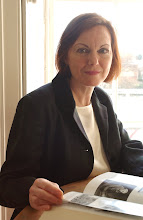
 The Football Association left Russell Square in 1929, but not before numerous stories of hauntings and poltergeist activity had circulated widely. This intrigued the Spiritualist Association of Great Britain, whose local branch in Marylebone began renting No. 42 in 1930. Regular seances took place in the house, including at least one led by Helen Duncan, the notorious fake medium prosecuted in 1942, the last person to be convicted in England under the 1735 Witchcraft Act. The top photo shows her materialising a 'spirit'.
The Football Association left Russell Square in 1929, but not before numerous stories of hauntings and poltergeist activity had circulated widely. This intrigued the Spiritualist Association of Great Britain, whose local branch in Marylebone began renting No. 42 in 1930. Regular seances took place in the house, including at least one led by Helen Duncan, the notorious fake medium prosecuted in 1942, the last person to be convicted in England under the 1735 Witchcraft Act. The top photo shows her materialising a 'spirit'.The inter-war years at No. 43 were not quite so exciting; it housed the offices of the London Federation of the League of Nations Union, which promoted peace as the world slid towards another global conflict, and the Inter-Varsity Federation, an evangelical Christian group. However, in No. 43’s top flat lived a very colourful character, Beryl de Zoete. Beryl was flamboyant ballet dancer who dabbled in all kinds of theatrical and dance forms, especially eastern, and would nowadays be called a “luvvie” (lower photo by Cecil Beaton, 1941). In later life she met Arthur Waley, a distinguished orientalist who was an Assistant Keeper at the British Museum. They formed a rather scandalous partnership; he was much younger than she was, and living together unmarried was something shocking in the 1920s. However, the pair’s relationship endured over many decades. The writer James Cahill visited them in 1956 and wrote,
“I went alone to the meeting with Waley, who was living quietly in an upstairs apartment on Russell Square, with his longtime companion Beryl de Zoete. She was a specialist in Asian dance, and quite old by this time; she scarcely spoke, but sat by the stove wearing a cap with a green celluloid shade, reading. The flat was disheveled and comfortable-looking, with a smell of wood smoke.”
During the war, Arthur Waley was employed as a censor at the Ministry of Information, vetting letters and telegrams written in Japanese. He found the work boring, and relieved the tedium by writing to the senders of the letters criticising their sloppy handwriting and poor grammar! He left No. 43 when Beryl de Zoete died in 1962.
Nos. 42-43 fortunately escaped damage in the Blitz, though neighbouring No. 40 took a direct hit and, with No. 39, lay a derelict shell for years until rebuilding merged the two buildings in 1962. The Spiritualist Association had wisely (and perhaps not surprisingly!) foreseen this and built a robust air-raid shelter in the basement of No. 42.
After the war, No. 42 became home to a succession of publishers such as St. Bride's Press. Iliffe Books, Temple Press and Hide Books, mostly subsidiaries of Reed International. Then in 1977 the building became the new home of the German Historical Institute. There was a small private cinema in the basement of No. 42 in these postwar years.
